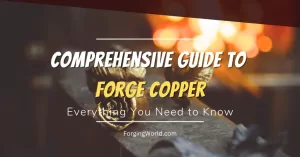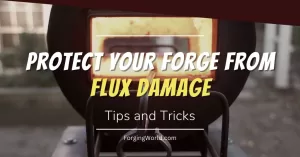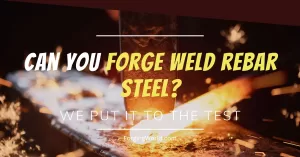Blacksmithing is a craft in which you will always have something new to learn. As a beginner, you have to learn the fundamentals first, including basic knowledge about tools, fuels, forging techniques, and safety. While these basics may be enough for making some basic projects, I would encourage you to add a new skill, called forge-welding.
Forge welding is a crucial skill to acquire if you want to become a serious blacksmith. However, basic blacksmithing skills like drawing out, upsetting, bending, and cutting must be learned first before starting with forge welding. Forge welding is a little tricky, especially if you are new to this. Both blacksmiths and welders are encouraged to practice this skill a lot. Learning forge-welding will open a lot more possible projects you can make.
Since I see many people wondering whether it is possible to forge weld in a propane forge, I decided to write an extensive guide on this topic.
In this guide you will learn:
- Forge welding basics
- Is it even possible to forge weld in a gas forge
- Do you need flux to forge weld in a gas forge
- Propane or natural gas for forge welding
- The best forge setup for forge welding
- Forge welding tips and tricks
Without further ado, let’s jump straight into it.
First of All, What Is Forge-Welding?
Simply said, forge welding is the process of fusing two metal pieces together. It is also known as the oldest welding technique and has been used since ancient times. Forge welding is known as solid-state welding in which two pieces are heated and then hammered together. It is also one of the simplest welding methods which makes it convenient for beginners.
Welding is typically grouped into two major categories: fusion and diffusion welding. Fusion welding is based on the melting of the metals at the weld interfaces. Note that this type requires much higher temperatures than the melting point. On the other hand, diffusion welding refers to joining the metals without actually melting them. Welding is done on the surfaces where both pieces are fused while being in a solid state.
In this type of welding, the heat source is lower than the melting point which allows even heat distribution. A filler is typically not used here. Note that in forge welding, the whole welding area is evenly heated and can also be used for a broad range of hard steel. With the right heat, pressure, and technique, you can forge basically any two metals into one.
Fundamentals of Gas Forge
Propane or gas forge, whatever you want to call it, is becoming more and more popular in blacksmithing, especially among beginners. Namely, propane forge is easily available and very easy to use. The latter is the major reason why it is so popular. Every novice knows that getting started with blacksmithing involves a lot of learning about many different aspects. Some of them include forging techniques, tools, fuels, material choice, and safety.
Learning about fire management of solid fuels on top of that may be overwhelming for most novices. Propane forge solves the last problem because all you have to do essentially is to turn on the burner and tank. You do that and you are ready to forge. Propane forge makes both forging and forge welding a much simpler process for beginners.
The two most commonly used fuels for this kind of forge are natural gas and propane. While natural gas may be more affordable, propane has been shown to achieve higher temperatures, mainly due to its energy content. Namely, propane contains almost twice as much energy as natural gas. This makes a big difference when it comes to forging welding.
Note that propane also burns less volume per hour than natural gas. However, whatever you use, make sure you have proper ventilation as propane forge can be the source of carbon monoxide. Inhaling carbon monoxide can be extremely dangerous, so having a precise carbon monoxide detector, like Kidde Nighthawk Carbon Monoxide Detector, is highly recommended.
Don’t forget that propane forge is also neighbor-friendly. Unlike coal forge, propane forge won’t alarm all your neighbors about your blacksmithing work that is happening in your workshop. Propane doesn’t produce any smoke or smell that may annoy neighbors. This is important for people living in a residential area. Another great news about propane forge is the availability of propane. Unlike coal, for example, you can buy propane at many local hardware stores.
On the other side, a lump of good blacksmithing coal is getting harder and harder to find, mainly due to the numerous mine closings. My prediction is that propane forges will dominate the blacksmithing community, especially for knifemaking due to both practical and economical reasons.
Can You Forge Weld in a Propane Forge?
I suppose this question is primarily what brought you to read this article. I am actually shocked by the number of people who still think that gas forge cannot be used for forge welding purposes. This also includes some older, experienced blacksmiths. I suppose this may be due to the fact that early propane forges were primarily made for farrier use.
Since farriers didn’t need to achieve forge welding temperatures, propane forges simply weren’t designed for reaching forge welding temperatures. Back then, some people succeed with forge welding, but the majority of people didn’t. Since then, propane forges got a bad reputation for forge welding. But modern gas forges have evolved. For example, the burner design is much better, and the refractory use for insulation is much better.
You can forge weld in a propane forge because they can achieve the necessary temperatures for doing so. However, forge welding in a propane forge can be difficult due to the increased oxidation that occurs. Typically one or two burners are recommended, depending on the size of the forge.
Basically, with the proper type, the number of burners, and the appropriate internal volume of the chamber, you shouldn’t have many problems forge welding in a propane forge. I almost forgot one more crucial factor, and that is insulation.
Do You Need Flux to Forge Weld?
Before we answer whether you need flux or not, we must first explain what flux is and what is the role of flux in welding. Flux is primarily used to reduce the temperature at which scale and impurities become fluid on the metal’s surface. Flux protects the surface from erosion, mainly due to gas blasting against the material.
However, if you choose not to use flux, you have to raise the temperature so you can make the surface elements fluid. You have to understand that flux is not a strict requirement, but it makes the process much easier. When it comes to propane forges, note that some of them may not reach forge welding temperatures, so doing without flux would be impossible. To forge weld in propane forges heat should circulate all the way around.
Flux should be generally used to forge weld in a gas forge. Flux is not a 100% requirement but it increases the chances of making the weld. However, as long as you meet the basic requirements like clean steel, a neutral atmosphere, and enough heat, you will typically get a weld.
The other way of saying it would be that in theory it is possible but in practice not really. Even if you clean both pieces extremely well and immediately hammer them together, it might hold. Note that there is still a chance of a small film of rust developing on the reactive surface of the metal and your weld breaking. So, in most cases, I recommend using flux, especially if you are new to forge welding. Just because you saw some masters of the crafts welding without flux, doesn’t mean you should also do it.
Borax is by far the most popular flux used for forge welding purposes. It is historically the most reliable and consistent. Borax is also readily available, cheap, and can be also mixed with other additives to produce a better effect.
If you are from the UK, chances are you have never used any kind of flux. There may be two reasons for this, the British didn’t lose their blacksmith tradition which means new smiths can easily learn from the experienced smiths directly. The second may be due to the higher standards of iron in Britain.
Keep in mind that there are certain cases where the flux is inevitable, like in welding mild steel to high-carbon steel. On the other hand, the flux may not be needed when welding two mild steel pieces.
5 Tips for Forge Welding in a Propane Forge
In the end, I will give you 5 tips that will help you to drastically improve your forge welding. They include:
- Keep it clean
- Weld it, don’t smash it
- Don’t overflux
- Reduce the atmosphere
- Right timing
Let’s address each one in turn.
1. Keep it clean
This one is very simple. Before you start with any type of forging or welding, the surface has to be free of any forge scale. You can take an angle grinder and clean off all scales from the metals to be welded.
2. Don’t overflux
As you may already know, the purpose of flux is to keep oxygen out of your weld. However, you should never count on flux to clean your weld. Keeping the material clean is your job. Get the steel to a light red and apply enough flux so it looks like wet glass. Putting too much flux will do two bad things. First, you will produce inclusions in your weld. Second, it will spread all over and possibly burn you and anything around you.
3. Reduce the atmosphere
When you are forge welding, you want to reduce the atmosphere in your forge as much as possible. This means that you will have more fuel than oxygen inside the forge therefore you automatically reduce the chances of scale forming and ruining your weld.
When it comes to propane forge, you can easily monitor the atmosphere by simply watching the flame exiting the forge door.
If there is no flame exiting the forge, it means that you have an oxidizing atmosphere (all propane is burnt up). If you have a little flame (one to three inches) coming out of the forge means that you have a neutral atmosphere. Finally, if you have a long orange flame (three to six inches) coming out means you have a reduced atmosphere. Note that blue flame typically refers to the production of carbon monoxide.
4. Know when to remove the metal from the forge
Once you put enough flux, you can continue bringing your material to a welding temperature. The good thing about propane forge is that you don’t have to worry about the rate of heating due to the low possibility of localized heat. With propane forge, all you need to do is to get the metal to a high orange/low yellow heat and you will be just fine.
There is one common way of knowing the right timing to weld. It is by simply observing the color of the material and flux. What you are looking for is a yellow/white color. In regards to flux, you should watch for the flux boiling on the surface of the metal. This is also my favorite method.
5. Hammer it quickly and carefully
When you are almost finished with heating the material, make sure everything is prepared for hammering. You want to start hammering as quickly as you possibly can before it becomes too late. Your anvil should be close to the forge so you can start quickly. You should know exactly where your hammer is. When you placed the billet on the anvil, strike it but not very hard. Start at one end and work your way to the other one. The strikes should be even and deliberate.
All you want is to set a weld, not to draw the metal. You can do that later. If you strike the metal too hard you can easily make layers slip sideways which would cause problems. After welding a couple of pieces, you will exactly what I mean.



